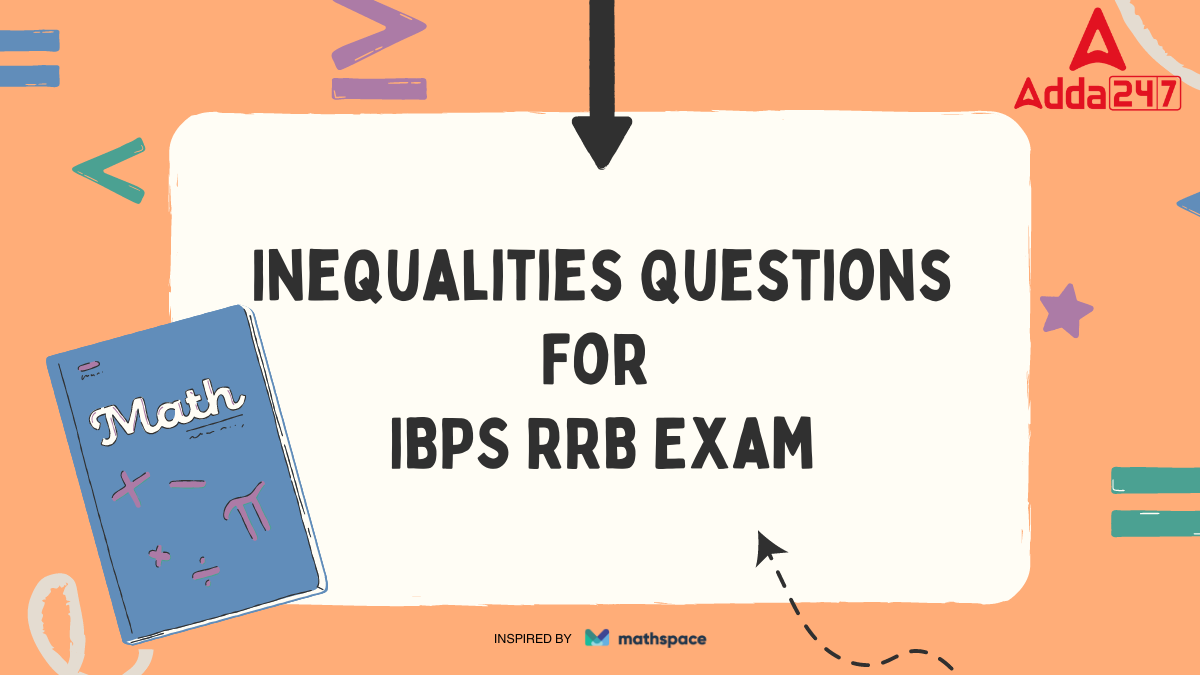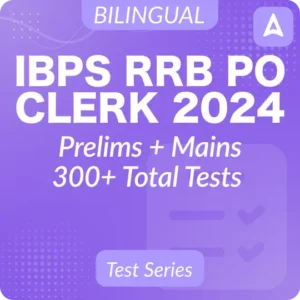Table of Contents
Cracking the IBPS RRB (Institute of Banking Personnel Selection- Regional Rural Bank) exam is aimed at many aspiring candidates looking to establish a career in the banking sector. One of the crucial sections of this exam is the reasoning ability section, which includes a variety of question types. Among these, inequalities questions hold a crucial place. These questions test a candidate’s logical thinking and problem-solving abilities.
Inequalities for RRB Bank Exams
Inequalities questions are a part of the logical reasoning section in the IBPS RRB exam. These questions are designed to evaluate a candidate’s ability to understand and manipulate mathematical relationships and inequalities.
The questions typically involve symbols such as
- > Greater than,
- < Less than,
- ≥ Greater than or Equal to,
- ≤ Less than or Equal to, and
- = Equal to
Candidates need to determine the relationship between different variables based on the given inequalities.
Types of Inequalities Questions
1. Direct Inequalities: In direct inequalities, candidates are provided with a set of statements containing inequalities, and they need to find the correct relationship between the variables. For example:
- Given: A > B, B > C
- Question: What is the relationship between A and C?
- Answer: A > C
2. Coded Inequalities: Coded inequalities involve symbols that represent the standard inequality signs. Candidates need to decode the symbols and solve the inequalities accordingly. For example:
- Given: A @ B means A > B, A # B means A = B, A $ B means A < B
- Question: If P @ Q and Q $ R, what is the relationship between P and R?
- Answer: P > Q > R, so P > R
3. Combined Inequalities: In these questions, multiple inequalities are given, and candidates need to combine them to determine the relationship between two variables. For example:
- Given: A > B, B = C, C < D
- Question: What is the relationship between A and D?
- Answer: A > B = C < D, so the relationship between A and D cannot be determined directly.
Inequalities Questions For IBPS RRB Exam
Directions (1-5): In the following questions, the symbols $, @, %, & and # are used with the following meanings as illustrated below:
‘A $ B’ means A is neither greater nor smaller than B
‘A @ B’ means A is neither greater than nor equal to B
`A % B’ means A is neither smaller than nor equal to B
‘A& B’ means A is not smaller than B
‘A # B’ means A is not greater than B
In each of the following questions, assuming the given statements to be true, find out which of the two conclusions I and II given below them is/are definitely true. Give answer
a) if only conclusion I is true.
b) if only conclusion II is true.
c) if either conclusion I or II is true.
d) if neither conclusion I nor II is true.
e) if both conclusions I and II are true.
Q1. Statements: W&P, P %G, G @ I, I # N
Conclusion: I. N%W
Conclusion: II. N # W
Q2. Statements: U @ D, D $ E, E % Y, Y& W
Conclusion: I. U @ Y
Conclusion: II. W %D
Q3. Statements: Z % N, N # K, K $ M, M @ R
Conclusion: I. M $ N
Conclusion: II. M% N
Q4. Statements: V&D, D %T, K $ T, K # F
Conclusion: I. V% F
Conclusion: II. V% K
Q5. Statements: S $ Q, Q @ B, B &K, K # W
Conclusion: I. W%K
Conclusion: II. S @ B
Directions (6-10): In these questions, the relationship between different elements is shown in the statements. The statements are followed by two conclusions. Give answer
(a) if only conclusion I is true
(b) if only conclusion II is true
(c) if either conclusion I or II is true
(d) if neither conclusion I nor II is true
(e) if both conclusions I and II are true.
Q6. Statements: F < R, R ≥ O, O = M, M ≤ T = K
Conclusion: I. K ≥ O
Conclusion: II. F > M
Q7. Statements: B = R, R ≥ T < O, O = P, P ≥ S
Conclusion: I. B < O
Conclusion: II. T < S
Q8. Statements: P > Q ≥ A, A < R, R = I
Conclusion: I. A < P
Conclusion: II. I > A
Q9. Statements: G = N, N ≤ O ≥ P, P > Q = R
Conclusion: I. P > G
Conclusion: II. P ≤ G
Q10. Statements: F < O, O = L, L ≤ W, L = S
Conclusion: I. W ≤ F
Conclusion: II. O = S
Directions (11-13): Read the statements carefully and answer the following questions.
Q11. In which of the following expressions will the expression ‘H < J’ be definitely true?
(a) G < H ≥ I = J
(b) H > G ≥ I = J
(c) J = I ≥ G > H
(d) H ≥ G > I < J
(e) None of these
Q12. Which of the following expressions will be true if the expression ‘K ≥ L > M ≥ N’ is definitely true?
(a) N ≤ K
(b) K = M
(c) K < N
(d) L ≥ N
(e) None is true
Q13. Which of the following expressions will be true if the expression ‘M ≥ K < T = Q’ is definitely true?
(a) Q < K
(b) M ≥ T
(c) K < Q
(d) T = M
(e) None is true
Directions (14-15): In each question, four statements showing a relationship have been given, which are followed by three conclusions I, II and III. Assuming that the given statements are true, find out which conclusion(s) is/are definitely true.
Q14. Statements: F ≥ M, M> A, R< A, E > R
Conclusion: I. M> E
Conclusion: II. F ≥ E
Conclusion: III. F< E
(a) Only I follows
(b) Only I & II follow
(c) Only II and III follow
(d) either II or III follows
(e) All follow
Q15. Statements: A ≥ B, M >B, D< M, F =D
Conclusion: I. B > D
Conclusion: II. B < A
Conclusion: III. M> F
(a) All follow
(b) Only I & II follow
(c) Only II and III follow
(d) Only either II or III follows
(e) Only III follows
Directions (16-20): In these questions, relationships between different elements are shown in the statements. These statements are followed by two conclusions. Give answer
(a) if only conclusion I is true
(b) if only conclusion II is true
(c) if either conclusion I or II is true
(d) if neither conclusion I nor II is true
(e) if both conclusions I and II are true
Q16. Statements: L ≥ D < M < P < A = F
Conclusion: I. F > D
Conclusion: II. P > L
Q17. Statements: Z ≥ M > F < A = B > S
Conclusions: I. Z > B
Conclusion: II. F < S
Q18. Statements: C > T > Q ≥ R = F
Conclusions: I. Q ≥ F
Conclusion: II. T > F
Q19. Statements: A = R ≥ Q, P < Q
Conclusions: I. A ≥ P
Conclusion: II. R > P
Q20. Statements: B ≥ M < Y = Z > F > T
Conclusions: I. B > F
Conclusion: II. Y > T
| Solutions | |||||||||
| 01 | 02 | 03 | 04 | 05 | |||||
| 06 | a | 07 | d | 08 | e | 09 | c | 10 | b |
| 11 | 12 | 13 | 14 | 15 | |||||
| 16 | a | 17 | d | 18 | b | 19 | b | 20 | b |
| Related Posts | |
| IBPS RRB Clerk Cut Off | IBPS RRB PO Cut Off |
| IBPS RRB Clerk Salary | IBPS RRB Preparation Tips |
| IBPS RRB Study Plan | IBPS RRB PO Salary |
| IBPS RRB PO Syllabus | IBPS RRB Clerk Syllabus |




 GA Capsule for SBI Clerk Mains 2025, Dow...
GA Capsule for SBI Clerk Mains 2025, Dow...
 The Hindu Review October 2022: Download ...
The Hindu Review October 2022: Download ...
 UCO Bank LBO Result 2025 Out, Direct Lin...
UCO Bank LBO Result 2025 Out, Direct Lin...


